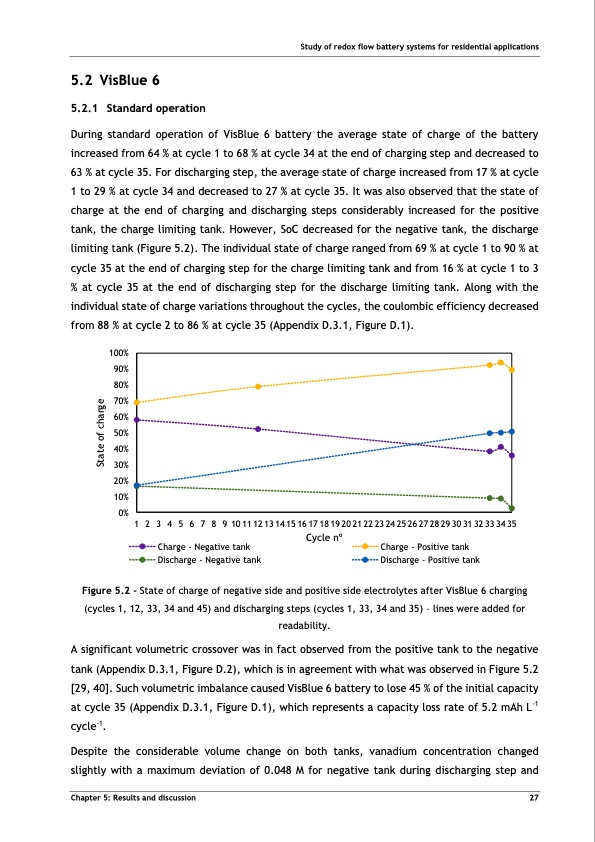
PDF Publication Title:
Text from PDF Page: 038
Study of redox flow battery systems for residential applications 5.2 VisBlue 6 5.2.1 Standard operation During standard operation of VisBlue 6 battery the average state of charge of the battery increased from 64 % at cycle 1 to 68 % at cycle 34 at the end of charging step and decreased to 63 % at cycle 35. For discharging step, the average state of charge increased from 17 % at cycle 1 to 29 % at cycle 34 and decreased to 27 % at cycle 35. It was also observed that the state of charge at the end of charging and discharging steps considerably increased for the positive tank, the charge limiting tank. However, SoC decreased for the negative tank, the discharge limiting tank (Figure 5.2). The individual state of charge ranged from 69 % at cycle 1 to 90 % at cycle 35 at the end of charging step for the charge limiting tank and from 16 % at cycle 1 to 3 % at cycle 35 at the end of discharging step for the discharge limiting tank. Along with the individual state of charge variations throughout the cycles, the coulombic efficiency decreased from 88 % at cycle 2 to 86 % at cycle 35 (Appendix D.3.1, Figure D.1). 100% 90% 80% 70% 60% 50% 40% 30% 20% 10% 0% 1 2 3 4 5 6 7 8 9 1011121314151617181920212223242526272829303132333435 Charge - Negative tank Discharge - Negative tank Cycle no Charge - Positive tank Discharge - Positive tank Figure 5.2 - State of charge of negative side and positive side electrolytes after VisBlue 6 charging (cycles 1, 12, 33, 34 and 45) and discharging steps (cycles 1, 33, 34 and 35) – lines were added for readability. A significant volumetric crossover was in fact observed from the positive tank to the negative tank (Appendix D.3.1, Figure D.2), which is in agreement with what was observed in Figure 5.2 [29, 40]. Such volumetric imbalance caused VisBlue 6 battery to lose 45 % of the initial capacity at cycle 35 (Appendix D.3.1, Figure D.1), which represents a capacity loss rate of 5.2 mAh L-1 cycle-1. Despite the considerable volume change on both tanks, vanadium concentration changed slightly with a maximum deviation of 0.048 M for negative tank during discharging step and Chapter 5: Results and discussion 27 State of chargePDF Image | Tubular Vanadium Air Redox‐flow battery

PDF Search Title:
Tubular Vanadium Air Redox‐flow batteryOriginal File Name Searched:
204521.pdfDIY PDF Search: Google It | Yahoo | Bing
Salgenx Redox Flow Battery Technology: Salt water flow battery technology with low cost and great energy density that can be used for power storage and thermal storage. Let us de-risk your production using our license. Our aqueous flow battery is less cost than Tesla Megapack and available faster. Redox flow battery. No membrane needed like with Vanadium, or Bromine. Salgenx flow battery
| CONTACT TEL: 608-238-6001 Email: greg@salgenx.com | RSS | AMP |